Environmental Analysis (CHP)
The Intergovernmental Panel on Climate Change (IPCC) is a scientific body created by the United Nations to produce objective and scientific conclusions on climate change. In the fifth assessment, harsh and definite words stated that “Human interference with the climate system is occurring, and climate change poses risks for human and natural systems” (IPCC, 2014). The various experiments and data from scientists across the globe have showed that the current warming and extreme weather trends are very likely due to human impact. The 2014 report determines that climate change by humans is leading to deadly and expensive impacts. As such, it has becoming necessary to value the impacts of human activities on the environment.
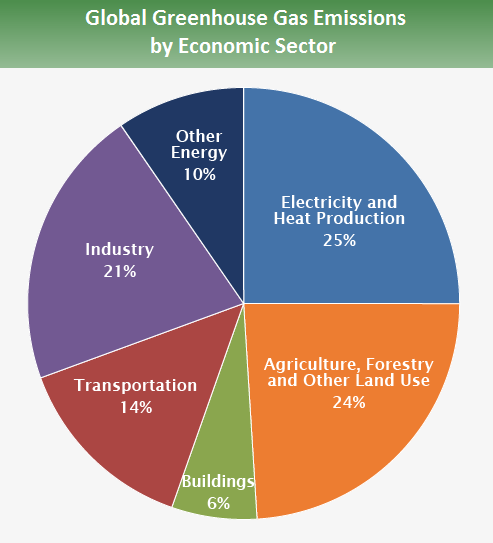
Greenhouse gas pollution from fossil fuels is a primary culprit (IPCC – Summary, 2014). The best estimates indicate that about 50% of observed climate change is due to greenhouse gases (NOAA Paleoclimatology Program, 2009) with carbon dioxide equaling 65% of greenhouse gases emissions (Global Greenhouse Gas Emissions Data, 2016). “Carbon dioxide is one of the most important greenhouse gases (GHG) as it traps the solar heat close to the Earth’s surface and absorbs infrared radiation at particular wavelength” (Osman, 2006). The current trends show carbon dioxide levels increasing at the same dangerous rate of global temperatures (IPCC – Summary, 2014). The research shows us that we cannot ignore what is happening. If steps are not taken to decrease greenhouse gas emissions, the implications will be deadly.
Energy and heat consumption and production is extremely important for climate change due to its large impact on GHG emissions. Information from the IPCC report in 2014 shows that GHG emissions from electricity and heat production lead to about 25% of all GHG. With such a large part of the equation, there is a large opportunity to improve GHG emissions in heat and power production. Implementing low-carbon energy options will have the most significant impact on carbon emissions. Low-carbon options include bioenergy, solar energy, geothermal energy, hydropower, ocean energy, and wind energy. Alternative carbon saving options have lower impacts on reducing GHG and climate change, yet are still important opportunities with other fuels (IPCC – Renewable Energy, 2014). Combined heat and power is an energy system option that has been proposed to reduce GHG emission.
An important aspect in determining the feasibility in implementing CHP at Lafayette College’s campus is understanding the environmental benefits and drawbacks. The environmental aspects of CHP pull from social, political, technical, and economical aspects while also having a distinct impact on resource usage and pollution. This analysis presents environmental implications through life cycle analysis, efficiency, infrastructure management, and cultural applications.
Life Cycle Analysis

Life-cycle Analysis (LCA) is a process that evaluates the environmental burden through the identification of inputs, life-cycle chain, products, and emissions. LCA is also known as Life-cycle Assessment, Ecobalance, and Cradle-to-grave Analysis. It is a technique that has various methods and models with numerous different support tools. The basic four steps to LCA are: goal and boundary definition, inventory analysis, impact assessment, and impact interpretation. Most of the differences in LCA come from the goal and boundary definition. Despite the different methods and models, LCAs are extremely helpful in determining both the environmental and economic validity of a product.
Due to the lack of technical information available of Lafayette College’s energy usage and steam production, a LCA for implementing CHP on the campus could not be completed at this time. Instead a review of literature on LCA of CHP systems was performed to understand the impact of CHP. It is important to note that this analysis focuses on implementing combined heat and power from a conventional heat generation and grid electricity.
To briefly summarize the research on LCA of CHP, specifically in comparison with conventional systems, combined head and power reduces emissions in the production of heat and electricity at a variation of sizes and fuel types. The case studies and models showed that both the energy generated and energy demand ratio of CHP is more efficient than the conventional system (Keesom, 2009; Dones, 2007) and that the life of the system (construction and hardware, operations and maintenance, decommissioning and disposal) is a reduction of emissions in comparison to the conventional system (Michaelis, 1998; Shen, 2015; Bailis, 2014; Keesom, 2009; Baron, 2004; Kelly, 2014; Osman, 2006; Osman, 2008; Dones, 2007; Roman, 2016; Friesenhan, 2016). The research also showed that the fuel type was important in determining the amount of emissions reductions (Dones, 2007; Osman, 2008 Keesom, 2009). The research showed that for fossil fuel production for combined head and power natural gas had the lowest environmental (emissions and pollution) impact while when only used for electric generation had the highest environmental impact (Osman, 2008). Although there is much to be learned from the various LCAs, the important take away is that implementing CHP from a conventional system will lead to a reduction in heat and electricity generation.
One model that is growing in popularity is the Greenhouse gases, Regulated Emissions, and Energy use in Transportation (GREET). It was developed by Argonne National Laboratory for vehicles and fleet life cycle analysis. Argonne National Laboratory has constantly updated and upgraded the model so that it has become an expansive vehicle and energy system life-cycle model. Due to the availability and ease, this model is recommended for future modeling of CHP at Lafayette College.
For more information on GREET, check out information on Argonne GREET website.
Efficiency
Implementing CHP should lead to major efficiency improvements at Lafayette College, as CHP are fundamentally more efficient systems. Since the objective is to understand CHP in comparison to the current system, the accurate way to compare the systems is through the total efficiency of the system.

Determining the efficiency of the system is based off of the fundamental idea of energy in and energy out (Radovic, 1997). It can be calculated by the equation in Figure 3. The variables represent: no stands for the system efficiency, We for the net useful electric output, Qth stands for the thermal output, and Qfuel is the fuel energy input. Each step of the system from fuel extraction, electric and heat generation, and grid distribution (including lines and connection efficiencies) is important in determining the total system efficiency, with each producing an no. To determine the final efficiency the efficiencies of each part of the system are factored together to produce the overall efficiency. Without information on the current systems and its input and output, it is difficult to accurately determine the efficiency of energy and heating generation at Lafayette College.
For more information on determining the Total System Efficiency, check out Overall Efficiency or Efficiency of Energy Conversion at Penn State University.
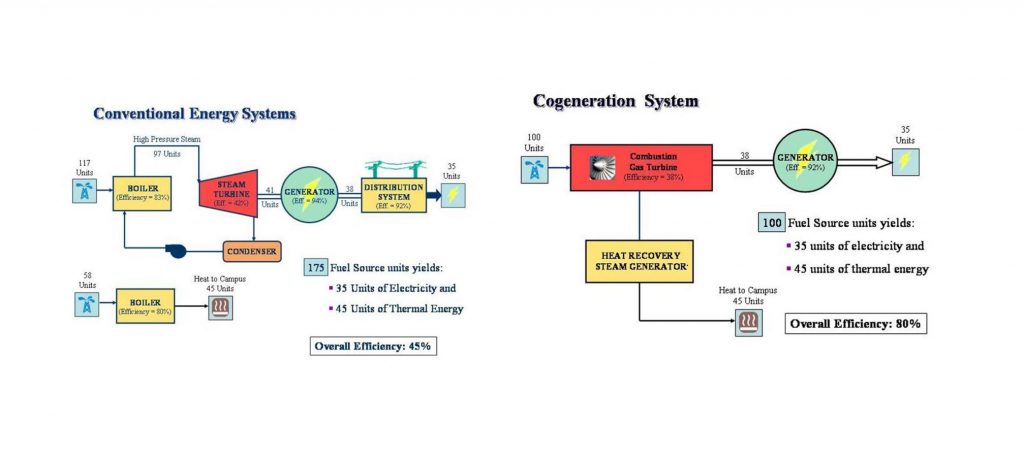
The current overall efficiency at Lafayette College would be around 30-50% efficient (Cogeneration Plant, 2015; Shen, 2015; Mohan, n.d.). Lafayette College’s system efficiency would most likely be lower due to line efficiency (U.S. Energy Information Administration, 2016) and the current steam generation efficiency (B. Ferretti, personal communication, October 13, 2016). While a CHP system at Lafayette College could have 60-90% efficiency, depending on the technical aspects of the system (Cogeneration Plant, 2015; Mohan, n.d.).
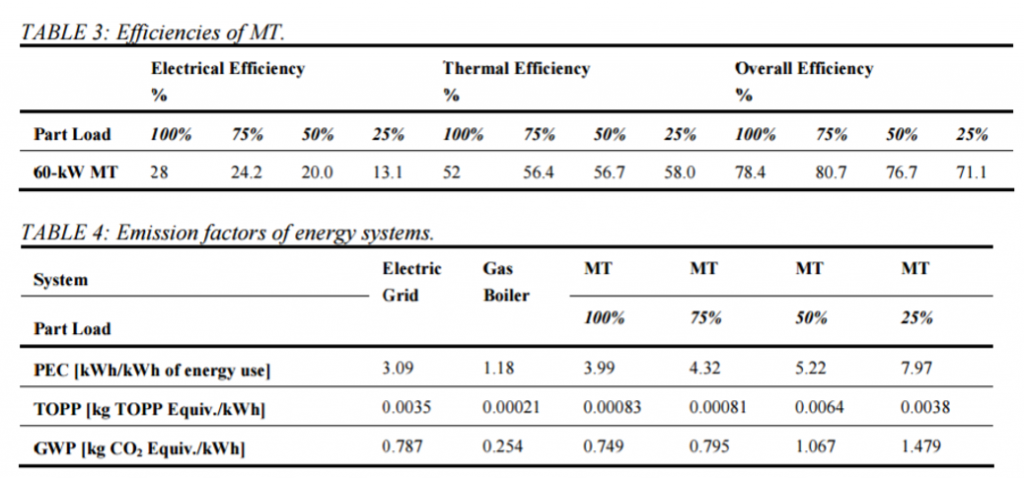
The efficiency of CHP would depend on the loads required. The higher the percent loads, the more efficient the electric and thermal efficiency would be, up to 75% part load (Osman, 2006). But with the increased load, comes an increase in pollution. Lafayette College is pursuing a number of expansion projects across campus and all projects will increase the load on campus for both thermal and electric.
Ultimately the emissions reductions for Lafayette College will be a result of increased efficiency of the system (Cogeneration Plant, 2015; Hyman, n.d.).
Infrastructure Management
Utility management is planning and operations of above and below ground utilities. The aspects of utility management look at the procurement, generation, distribution, and end-use for energy, heating and cooling, while also considering the potential social and community implications through analyzing how resources are being used and understood. Although there are a number of potential utility management planning and operations implementations this report presents how smart microgrids and tri-generation could improve utility usage at Lafayette College.
A smart grid is an electricity network that can intelligently integrate the actions of all users connected to it in order to efficiently deliver electricity (Hatziargyriou, 2014). Smart grids are more efficient, allow for non-constant energy sources, improve operation and maintenance capabilities, and respond better to extreme weather and disasters (Preparing and Restoring Power, 2016). Smart grids are planed so new technology or systems can be integrated, as the energy field is continuously adapting and changing.
A microgrid is a local energy grid with control capability, meaning it can separate from the grid (Lantero, 2014). Most of the time, microgrids are connected to the national grid but when a disaster strikes it helps isolate a system and keep in online. Microgrids are not new concepts but what makes them different today is the integration with smart grid technology. Some of the many benefits of implementing smart microgrids are that they “enhance local reliability, reduce emissions, improve power quality by supporting voltage and reducing voltage dips, and potentially lower costs of energy supply” (Hatziargyriou, 2014). Another potential benefit is that is can be set up to serve both electric and thermal necessities of local users (Baron, 2004). The different characteristics from a conventional system allow for stronger and more efficient management of the energy system and energy usage. One of the largest potential benefits for microgrids are the integration of renewable energies, in particular solar and wind. Implementing a smart microgrid at Lafayette College could allow for future renewable energy construction.
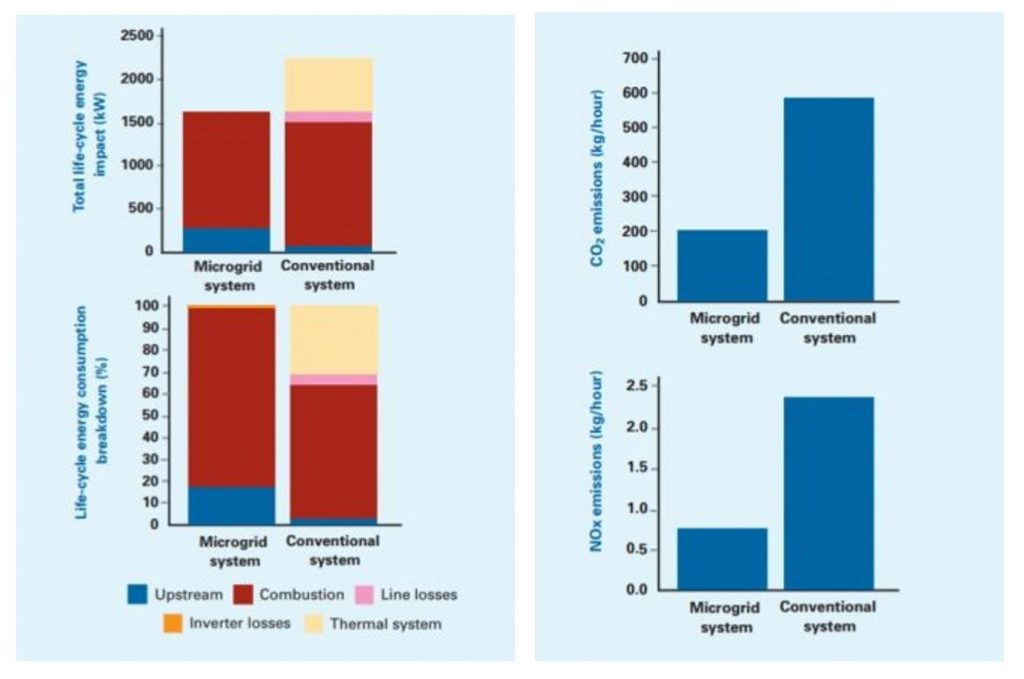
To determine the magnitude of potential microgrids in junction with implementing CHP, we can again use LCA. The analysis shows us is that while both systems produce the same amount of energy and heat, it takes less energy to produce and distribute on a local level (Baron, 2004; Hatziargyriou, 2014). When comparing a microgrid and CHP implementation to a conventional system, there is improvements in efficiency and reductions in emissions (Preparing and Restoring Power Grids Using Smart Technologies, 2016). So even when factoring in any construction, maintenance, and disposal, the system has environmental benefits.
Integrating a microgrid at Lafayette College would have social, technical and economic implications, because it would change the conversation around energy. Overall, the system would allow for a local system to be better managed and run, through an increase in data and responsibility. A microgrid would allow Lafayette College to understand how energy is being used and hopefully make changes to decrease loads and usage. It must also be understood that many of the benefits of CHP would not be possible if electricity is connected to the grid instead of being locally distributed to Lafayette College through a smart microgrid.
For more information on Microgrids at other colleges look at Smart Microgrids on College & University Campuses on AASHE.
Trigeneration is one of the most efficient ways for maximizing the utilization of available energy (Mohan, n.d.). Trigeneration or combined cooling, heat and power (CCHP), is the process which heat produced by CHP is used to generate chilled water for air conditioning or refrigeration. Typically an absorption chiller is used to provide the chilled water(Trigeneration, 2016). CCHP has many economic and environmental benefits as trigeneration leads to an increase in energy efficiency, leading to a potential 80-90% efficiency for a CHP system of 50-70% efficiency (Mohan, n.d.). CCHP is not typically recommended for current buildings due to size and cost, but could be a long term cost effective application for new construction (Nilsson, 2007 pg. 104).
Cultural Applications
When people flip the switch at Lafayette College they think nothing of it. Implementing CHP at Lafayette College will have more impacts then saving energy and reducing pollution. CHP could create a whole new way for the campus to look at energy.
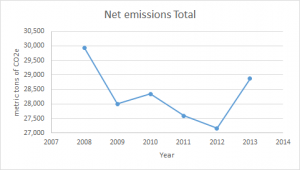
Lafayette College has been working to reduce its emissions yet with building expansion and increased enrollment, net emissions have increased. New buildings are planned such as the 100,000 SF Integrated Science Building and the Multi-Purpose Residence Hall (Byerly, 2016) and they will create increase emissions unless they are built at Zero Net Energy Building standards. If Lafayette College expects to achieve their goal of reducing its net emissions by 15%, drastic measures are needed.
Lafayette College can show its commitment to fighting climate change by fulfilling its commitment to reducing emissions and integrating sustainable design. Implementing sustainable development and design in the classroom and across campus is a key to the sustainability and success of college (Majerník, 2015). Some of the benefits of this are that students are better educated and oriented when they graduate and that the college receives long term economic, environmental, and social benefits from the reduction in pollution, decrease in cost burdens, and increase integration across the campus (Majerník, 2015).
The College has already responded to the opportunity to change traditional teaching and research through application of sustainable development and design. Through the environmental engineering degree, engineering studies degree, environmental science degree and various environmental focused design courses, the College has already integrated sustainable design into the curriculum. The College has taken this emphasis a step further by creating a composting program and an organic farm through initiatives started in classrooms or labs. The composting program at Lafayette College has had a long research career through the Society of Environmental Engineers and Scientists (SEES) while also involving student volunteers to help monitor the compost. The organic farm is both a working farm and a community garden that has student employment, EXCEL research opportunities, and community engagement platforms. The farm is also used on various occasions for courses by being a living laboratory for organic farming and community partnerships. Both programs are now valuable and integral parts of Lafayette College that provide educational, economic, and cultural value to campus. Both programs also incorporate a range of disciplines and are representations of the value of a liberal arts degree.
Implementing CHP could go a step futher by being not only a product of sustainable design and development at Lafayette College but by also act as a living laboratory. CHP could be used for performance calculations, data reconciliation, instrument bias ans stimulation, utility system costing, real gas performance, combustion emissions equilibrium, heat transfer calculations, optimal design and costing, and mechanical repair (Knopf, 2009). Some schools have already integrated CHP into the campus and education experience. Pacific Union College promotes student employment at its 24 hour cogeneration plant. Texas A&M hosts tours at plant. “This year alone, the plant has offered tours to over one thousand visitors. Most of our tours are engineering professors who make the tour part of their class; they will tour early in the semester to get a real-world understanding of the subjects the class covers” (Z. McNew, personal communication, December 5, 2016). Washtenaw Community College in Ann Arbor, MI teaches courses on training future energy professionals on their cogeneration system. LSU goes even further. Models based off real data have been created for courses and labs. Please check out one of the lesson plans for cogeneration application. ESRL Module 1. Ideal Gas Performance. These are all applications that Lafayette College could, and should, implement with the construction of CHP.
Should We Moving Away from Fossil Fuels
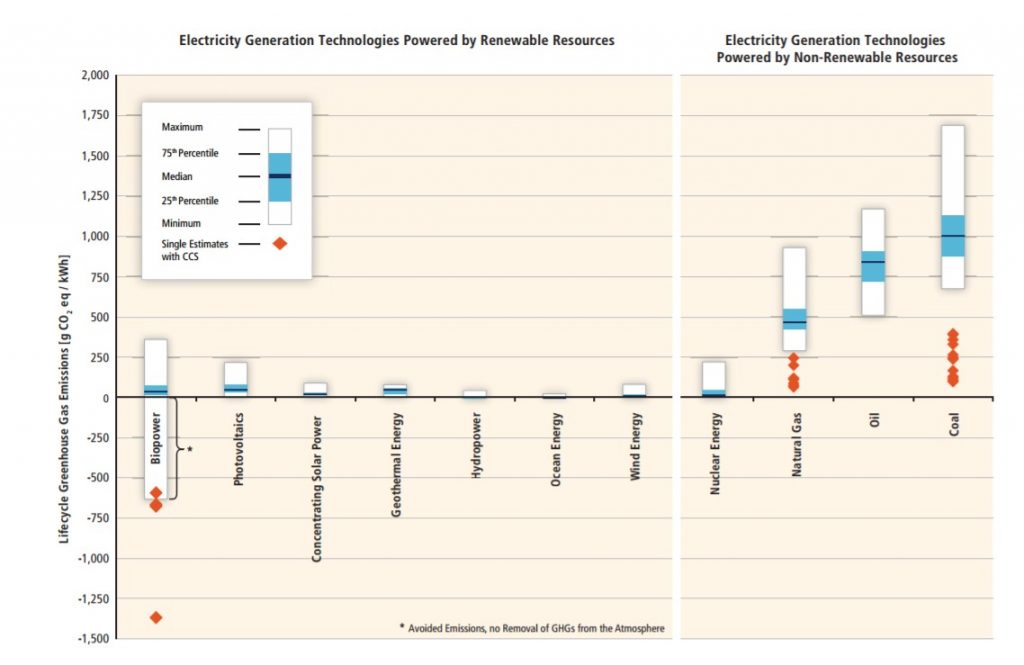
The biggest environmental issue with CHP is that is still uses fossil fuels as its fuel source. Even with the systems increased efficiency it still produces large environmental impact. Instead of looking to continuing fossil fuel projection, Lafayette College could be looking to implement other renewable energies such as bioenergy, solar energy, geothermal energy, hydropower, ocean energy, and wind energy. The IPCC looked at the current and potential carbon dioxide emissions of different fuel sources. Oil, coal, and natural gas all have higher lifecycle Greenhouse gas emissions than renewable energy resources, even at the lowest emissions, without Carbon Dioxide Capture and Sequestration (CCS)(IPCC, 2014). Instead of investing further in fossil fuels, Lafayette College should invest in creating a smart microgrid and connecting renewable energies, as this would have a better impact on the environment (Osman, 2006; IPCC 2014; Shen 2015).
Despite these concerns about the continuation of fossil fuel usage, CHP is still recommended. This is due to the simple technical application of CHP for Lafayette College and the quick environmental and economic benefits. The current steam plant is a very close to having CHP and implementing it would be a step in the right direction. The environmental research and analysis conducted showed that in comparison to a conventional system, CHP has a reduced environmental impact. If Lafayette College was considering constructing a whole new natural gas CHP plant, this report would most likely produce a different recommendation.
Recommendation
Overall, Lafayette College could achieve a number of environmental benefits from implementing CHP at Lafayette College. The system is a more efficiency system that would increase Lafayette College’s responsibility on generation and consumption. Regardless, Lafayette College should consider constructing a smart microgrid that would allow for better utility management and future renewable energy growth.
